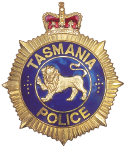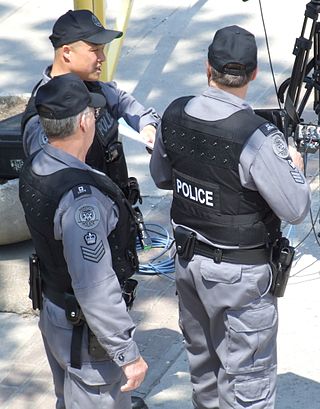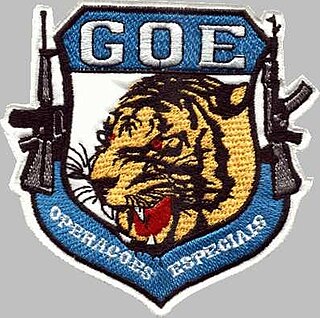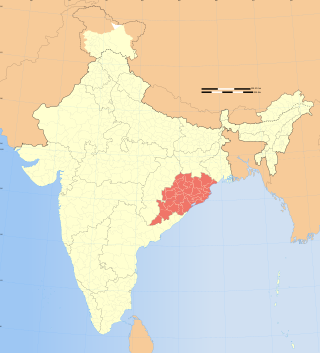Related Research Articles
The Critical Incident Response Group (CIRG) is a division of the Criminal, Cyber, Response, and Services Branch of the United States Federal Bureau of Investigation. CIRG enables the FBI to rapidly respond to, and effectively manage, special crisis incidents in the United States.

Tasmania Police is the primary law enforcement agency of the Australian state of Tasmania. Established in 1899, the force has more than 1,300 officers policing Tasmania's population of over half a million people.
The Police Special Intervention Unit (SIU) (Finnish: poliisin Valmiusyksikkö Karhu; Swedish: polisens beredskapsenhet), known as Special Intervention Unit Karhu, is the tier one national police tactical unit in the Helsinki Police Department (HPD) of the Police of Finland.

The Emergency Task Force (ETF) is the police tactical unit of the Toronto Police Service. Created in 1965, it is mandated to deal with high-risk situations like hostage-taking, emotionally disturbed persons, high-risk arrests, warrant service, protection details, and crowd control. The Emergency Task Force is also responsible for responding to any terrorist incidents that occur throughout the City of Toronto.

Special Tasks and Rescue Group is the Police Tactical Group of the South Australia Police.

The Special Task Force (STF) is the premier police tactical unit of the South African Police Service (SAPS). The Special Task Force handles high risk operations that fall beyond the scope of classic policing which require specialised skills.
The State Protection Group (SPG) is part of the Counter Terrorism & Special Tactics Command of the New South Wales Police Force and was established in 1991 to deal with extraordinary policing responses. The SPG directly supports police in high-risk incidents such as sieges with specialised tactical, negotiation, intelligence and command-support services. The unit also provides rescue and bomb disposal support, canine policing, and armoury services.
Special Emergency Response Team (SERT) is the Police Tactical Group of the Queensland Police Service (QPS) and also provides a high angle rescue response. SERT provides the QPS with the ability to respond to high risk situations incidents statewide. SERT is based in Brisbane and Cairns to ensure that specialists capabilities are available to support police at any location in Queensland.
The Special Operations Group (SOG) is the police tactical group of the Victoria Police. The SOG was Australia's first full time and dedicated police tactical group when it formed in 1977.

The Border Patrol Tactical Unit (BORTAC) is one of two police tactical units in the Special Operations Group, under the United States Border Patrol (USBP) that specialize in counterterrorism, high-risk tactical law enforcement situations, hostage rescue, operating in difficult to access terrain, reconnaissance, and tactical special operations. In 2007, BORTAC was placed under the command of the newly formed Special Operations Group (SOG) together with the Border Patrol Search, Trauma, and Rescue (BORSTAR).
The Security Operations Group (SOG) is a unit of elite corrections officers of Corrective Services NSW, Australia formerly known as the Hostage Response Group (HRG).

The Emergency Response Unit (ERU) is the police tactical unit of the Garda Síochána, Ireland's national police and security service. The unit was a section of the forces' Special Detective Unit (SDU), under the Crime and Security Branch (CSB) until 2017, when the Special Tactics and Operational Command was created to take over its operational duties alongside Armed Support Units.
Until July 2012 the Specialist Response and Security Team (SRS) was a Police Tactical Group of the Australian Federal Police (AFP) having responsibility for tactical and specialist operations within the Australian Capital Territory. The Operational Response Group (ORG) had responsibility for AFP National and International tactical operations. In July 2012 the SRS was merged with the ORG to create the Specialist Response Group.
Police tactical group (PTG) is the generic term used to refer to highly trained Australian and New Zealand police tactical units that tactically manage and resolve high-risk incidents, including sieges, armed-offender situations and terrorist incidents.
The Critical Incident Response Team (CIRT) is a specialist unit of the Victoria Police that provides assistance to general duties police, including a negotiator capability, to resolve high risk incidents utilising specialist tactics and equipment. CIRT was formed to conduct regular patrols of metropolitan Melbourne 24-hours, seven-day-per-week, ready to rapidly respond to incidents in Melbourne, and if necessary, in regional Victoria, by a small team of officers. CIRT has evolved to include conducting planned operations for high risk searches and arrests.

The Grupo de Operações Especiais, mostly known by its acronym GOE, was a tier two police tactical unit of the Brazilian Civil Police of the state of São Paulo, Brazil. It was comparable to Rio de Janeiro's CORE. In 2019, the Governor of the State of São Paulo, João Dória, extinguished the group and its members were moved to the newly created Department of Strategic Police Operations.
The Trup Tindakan Cepat, or TTC, is an elite counter terrorism unit within the Malaysian Prison Department.
The Special Operations Group (SOG) is a tactical unit of the Jammu and Kashmir Police (JKP) that is specialized in counter-terrorism and counter-insurgency.

The Special Operation Group (SOG) is a police tactical unit that specialized in quick response to emergencies with SWAT unit tactics especially in mountainous forest areas. It was raised by the Odisha Police (OP) to combat the left-wing extremists in the state.
References
- 1 2 3 Police Association of Tasmania President Colin Riley (18 December 2019). "SOG-ies' anniversary well worth celebrating". The Examiner. Retrieved 27 February 2020.
- ↑ "Tasmania Police Business Priorities 2020–21" (PDF). Tasmania Police. p. 3. Retrieved 16 August 2021.
- 1 2 3 Judy Tierney (15 October 1999). Elite police group pushes hard to find the right stuff. 7.30 Report (Television production). Australian Broadcasting Corporation. Archived from the original on 28 February 2017.
- 1 2 3 Minister for Police, Fire and Emergency Management Felix Ellis (5 August 2024). "Crooks on notice: Full-time Special Operations Group keeping Tasmanians safe". Premier of Tasmania (Press release). Retrieved 7 September 2024.
- 1 2 Tasmania Police (18 December 2018). Tasmania Police Manual (PDF).
- 1 2 "Special Operations Group (SOG)". Tasmania Police. Archived from the original on 25 February 2008.
- 1 2 3 4 5 6 Eastwood, Gary. "Inside the SOG" (PDF). Police Association News (June 2011). Police Association of Tasmania. ISSN 1327-7626. Archived from the original (PDF) on 19 March 2012.
- ↑ Police source book 2 / edited by Bruce Swanton and Garry Hannigan ; assisted by Trish Psaila (PDF). Phillip, A.C.T: Australian Institute of Criminology. 1985. ISBN 0-642-07831-9.
- ↑ Westwood, F.D. (20 September 1993). Award variation – restructuring and rates of pay – Structural Efficiency Principle – special case applications – Police Award (PDF). Tasmanian Industrial Commission.
- ↑ "R v Ian Roger Matterson Ex Parte Christine Debra Moles [1994] TASSC 184". Austlii. Supreme Court of Tasmania. 22 December 1994. Retrieved 13 June 2024.
- ↑ O'Loughlin, Heath (2017). Sons of God : inside the secret world of our Special Operations Group. Sydney, New South Wales: Pan Macmillan. ISBN 978-1-74353-937-8.
- ↑ Dale, Amy (31 March 2015). "Port Arthur Massacre: Off duty Sydney policeman Justin Noble's actions saved lives including that of his pregnant wife". The Daily Telegraph. Archived from the original on 7 October 2017.
- ↑ "Police speak about Port Arthur murderer". The Sydney Morning Herald. 9 April 2006. Retrieved 29 July 2016.
- ↑ Silvester, John (13 September 2014). "Naked city: Special Ops vet and Patch do the hard yards". Sydney Morning Herald. Retrieved 29 July 2016.
- ↑ Aquilina, Sarah (20 March 2019). "Special Operations Group deployment more than doubles in five years". The Examiner. Retrieved 5 March 2020.
- ↑ "Police storm house, bangs heard in dramatic end to Launceston siege". ABC News. Retrieved 5 March 2020.
- ↑ "Man and woman in custody following Trevallyn incident". Tasmania Police (Press release). 8 December 2018. Retrieved 5 March 2020.
- 1 2 McKay, Danielle (27 September 2009). "Elite cops in short supply". The Mercury. Archived from the original on 7 October 2012.
- 1 2 Worley, Mark (6 August 2007). "Anti-terror unit disbanded". The Mercury.
- ↑ Haley, Martine (20 May 2003). "$3.7m special unit to guard against terror". The Mercury. p. 5.
- ↑ Annual Report July 2003 – June 2004 (PDF). Tasmania Department of Police and Public Safety. p. 20.
- ↑ Bennett, Andrew (14 December 2018). "Community deserves full-time officers". The Examiner. Retrieved 5 March 2020.
- ↑ Minister for Police, Fire and Emergency Management Michael Ferguson (25 June 2018). "Over $9 million in illicit drugs seized". Premier of Tasmania (Press release). Retrieved 29 July 2018.
- ↑ Minister for Police, Fire and Emergency Management Mark Shelton (1 November 2019). "Delivering our promise to boost police numbers". Premier of Tasmania (Press release). Retrieved 26 February 2020.
- ↑ Minister for Police, Fire and Emergency Management Mark Shelton (12 November 2020). "Additional frontline Police Officers to keep Tasmanians safe" (Press release). Retrieved 16 August 2021.
- ↑ Riley, Colin (11 February 2021). "Talking Point: Shocking figures reveal toll of stress on police force" . The Mercury. Retrieved 16 August 2021.
- 1 2 "Special Operations Group – Legislative Council". Parliament of Tasmania. 10 November 2009.
- ↑ Judy Tierney (9 March 2000). A Few Good Men. Australian Story (Television production). Australian Broadcasting Corporation. Archived from the original on 14 December 2021. Retrieved 12 July 2017.
- ↑ Attorney-General for Australia Nicola Roxon (15 March 2012). "New high-tech 'Bearcat' armoured rescue vehicles announced". Attorney-General's Department (Press release). Archived from the original on 16 March 2012.
- ↑ "Launch of new Armoured Tactical Vehicle". State Security (Press release). 23 February 2006. Archived from the original on 20 August 2006.
- ↑ "BearCat ready for duty". The Examiner. 19 June 2012. Retrieved 29 July 2016.
- ↑ Government Services Budget Paper No 2 Volume 1 (PDF). 2019-20 Tasmanian Budget. Parliament of Tasmania. May 2019. p. 184.
- 1 2 Minister for Police, Fire and Emergency Management Jacquie Petrusma (25 December 2021). "Contract awarded to build the Southern Special Operations Group Facility". Jacquie Petrusma (Press release). Archived from the original on 20 January 2022.
- ↑ Department of Police, Fire and Emergency Management Annual Report 2021–22 (PDF). Tasmanian Government. p. 9. ISSN 2207-0494 . Retrieved 21 October 2023.
- 1 2 Minister for Police, Fire and Emergency Management Felix Ellis (14 December 2022). "New $3.6 million Special Capabilities Building to support Tasmania Police". Premier of Tasmania (Press release). Department of Premier and Cabinet. Retrieved 21 October 2023.